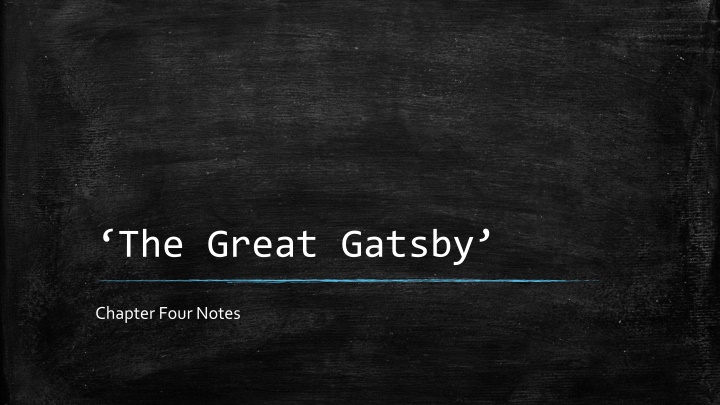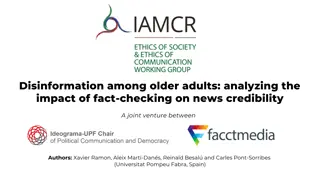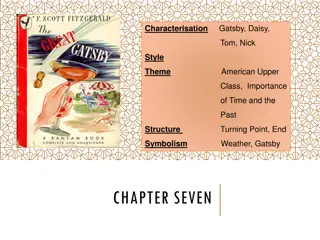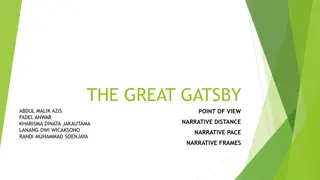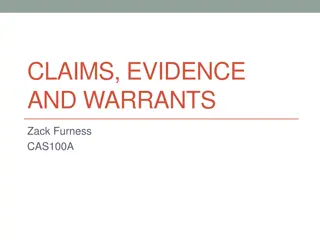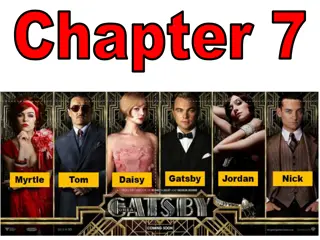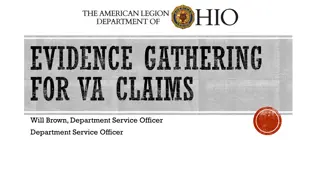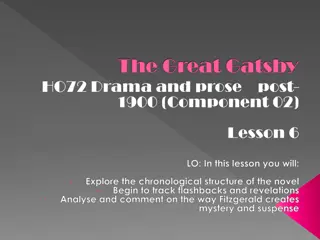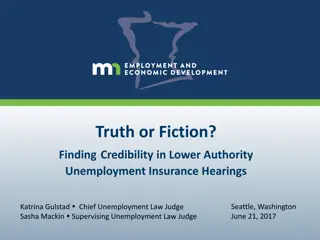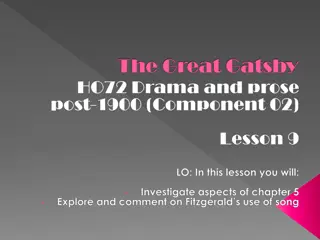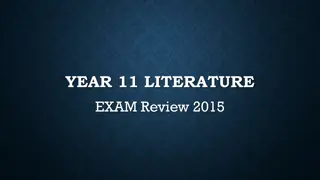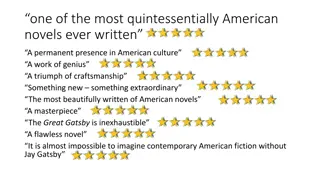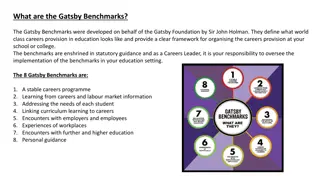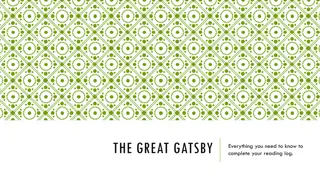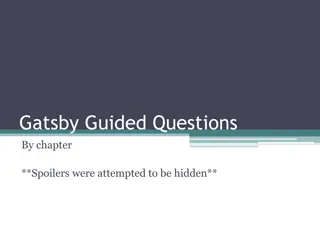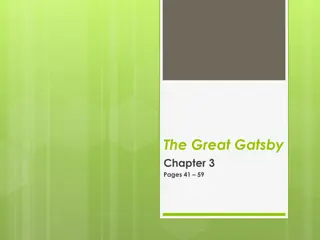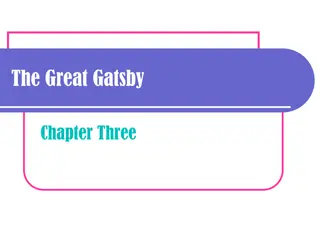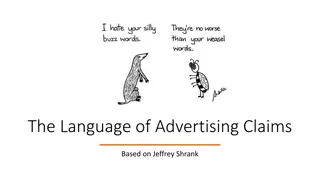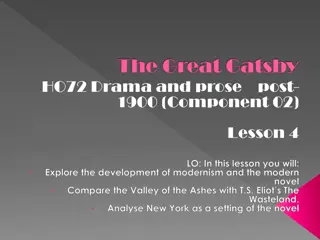Analysis of Gatsby's Claims and Credibility in Chapter Four of The Great Gatsby
Chapter four of The Great Gatsby delves into Gatsby's past, where he makes grand claims about his heritage, wealth, education, and war hero status. Nick finds Gatsby's story incredulous and doubts its authenticity, viewing Gatsby as a fantastist. However, Gatsby attempts to restore his credibility by providing evidence, leaving an air of mystery around his true self.
Download Presentation

Please find below an Image/Link to download the presentation.
The content on the website is provided AS IS for your information and personal use only. It may not be sold, licensed, or shared on other websites without obtaining consent from the author.If you encounter any issues during the download, it is possible that the publisher has removed the file from their server.
You are allowed to download the files provided on this website for personal or commercial use, subject to the condition that they are used lawfully. All files are the property of their respective owners.
The content on the website is provided AS IS for your information and personal use only. It may not be sold, licensed, or shared on other websites without obtaining consent from the author.
E N D
Presentation Transcript
The Great Gatsby Chapter Four Notes
Summary Chapter four is split into four distinct sections: 1-Nick lists the various guests who attend Gatsby s lavish parties over the course of the summer. 2-Gatsby visits Nick s home and invites him to lunch. As they drive to New York, Gatsby tells the narrator about his past. 3-Gatsby and Nick lunch with an associate of Gatsby called Meyer Wolfsheim. He is a shady individual who has thrived in the criminal underworld. 4-Jordan informs Nick that Gatsby and Daisy had a brief romantic liaison during the war. Gatsby is desperate for a reunion.
Gatsbys Past The protagonist makes a number of seemingly outlandish claims about his past. Nick also detects a lack of conviction in Gatsby s voice when he claims to be Oxford educated. This supports Jordan s claims of the previous chapter. I knew why Jordan Baker had had believed he was lying. He hurried the phrase educated at Oxford , or swallowed it, or choked on it, as though it had bothered him before. It is thus suggested to readers that Gatsby has constructed an artificial persona which does not hold up to scrutiny. This casts doubt over his claims to a natural affinity with old world Anglican values.
Gatsbys Claims In his account of his past, Gatsby claims the following: He is descended from a rich mid-Western family. As heir to this fortune he inherited his vast wealth from his deceased parents. He completed his formal education at Oxford University. After experiencing something sad , he indulged himself in the capitals of Europe. He served with distinction in the First World War and is a decorated and venerated war hero.
Nicks Response With an effort I managed to restrain my incredulous laughter. The very phrases were worn so threadbare that they evoked no image except that of a turbaned character leaking sawdust at every pore as he pursued a tiger through the Bois de Boulogne. Nick considers Gatsby s tale to be a clich d fantasy with no grounding in reality. He perceives of the protagonist as a faintly ridiculous fantasist. At this point, we doubt Gatsby s credibility and are inclined to consider him worthy of our contempt. At this point we feel that we have yet to have any insight into Gatsby s true self.
Credibility Restored? Gatsby immediately challenges the impressions formed by Nick and shared with the reader by providing proof. He first shows Nick a medal he was awarded by Montenegro: To my astonishment, the thing had an authentic look Gatsby then shows Nick a picture of himself at Oxford and Nick says, Then it was all true. While Nick instantly regards Gatsby in a more sympathetic light, we continue to doubt his authenticity. The protagonist thus retains an air of mystery.
Meyer Wolfsheim An unsavoury character who represents the criminal underworld. His association with Gatsby suggests that Gatsby s wealth may originate in criminality. Unlike Gatsby, Wolfsheim is open about his occupation: His expressive nose Let the bastards come in here Fine specimens of human molars Just as we seem to gain some understanding of Gatsby, this is again snatched away. He remains a mystery.
Not So Great Gatsby They can t get him, old sport. He s a smart man. This quotation suggests admiration on the part of Gatsby for Wolfsheim. Rather than be repulsed by the nature of the crime, he is in awe of the success of the criminal. We further question Gatsby s judgements when he says of Jordan: Oh, it s nothing underhand...Miss Baker s a great sportswoman...she d never do anything underhand As Nick has previously described Jordan s proclivity for dishonesty, we are forced to question Gatsby s judgements of others.
GATSBYS RELATIONSHIPS WITH OTHER CHARACTERS Gatsby s association with Wolfsheim shows another side to his character. Implication that his lavish lifestyle is funded by crime. Gatsby symbolises both the luxury and corruption of the Jazz Age.
Narrative Change Nick allows Jordan to assume the narration by reporting her account of Gatsby and Daisy s past verbatim. This has the advantage of giving us insight into an event Nick is unable to describe. It also retains the ostensible neutrality of Nick s narration as it is told by an individual who is not directly involved. Our knowledge of Jordan s personality means that we must treat her narration with a degree of caution.
The Revelation Nick reveals that Daisy and Gatsby enjoyed a brief relationship during the war. Jordan repeatedly mentions Daisy s wearing of virginal white. This again emphasises her apparent virtue and innocence. Daisy s parents did not approve of this match. We presume that this relates to Gatsby s social status. On the day before her wedding, Daisy was briefly desirous of calling off the wedding after receiving a letter from Gatsby.
Pearls versus Paper The letter and the pearl necklace are important symbols of stability and status at this crisis point in Daisy s life. As Gatsby s letter come apart in hands like snow , her decision seems to have been made for her. Gatsby s love is perceived as transient and unstable, whereas Tom s version of love represents rock solid permanence, by virtue of its immutable wealth. She didn t say another word. We gave her spirits of ammonia and put ice on her forehead and hooked her back into her dress, and half an hour later, when we walked out of the room, the pearls were around her neck and the incident was over.
Pearls versus Paper Daisy, through choice, has become an emblem of Tom s old money. She abandons her romantic urges, casts off her emotional coat and embarks on a marriage which will offer stability of status. Note the effort of the others to ice her into submission, cooling her truer passion for the man she loved. Also notable is the waythey hook her into her dress. From this it can deduced that Daisy has been reduced to a piece of meat in this transaction. This is borne out in Jordan s recollection of how Tom began cheating on her almost immediately after the wedding was over, as well as his love of alcohol.
Gatsbys Admirable Qualities Gatsby bought that house so that Daisy would be just across the bay. In contrast to the fickle nature of Daisy s love, Gatsby s feelings are shown to be intense and enduring. This casts Gatsby as a hopeless romantic who is commendably loyal to the object of his desires. We are thus faced with a dual representation of Gatsby in this chapter. He is both an underhand criminal and a man capable of great loyalty and love.
Nicks Changing View I had talked with him perhaps a dozen times in the past month and found, to my disappointment, that he had little to say he had become simply the proprietor of an elaborate roadhouse next door. TO He came alive to me, delivered suddenly from the womb of his purposelessness splendour. This volte-face reminds readers that they are reading from Nick s perspective and that his narrative is coloured by his own prejudices. We can expect Gatsby to be treated more deferentially owing to Nick s admiration for his loyalty and romantic sensibilities.
Increased Knowledge The revelations about Gatsby s past deconstructs some parts of the Gatsby mystery: - We know that he has hosted lavish parties in an attempt to ensure that Daisy attends thus facilitating a reunion. - The green light he reaches towards in chapter one is close to Daisy s home. It is clear now that he was reaching towards the object of his desires.
Symbolism- The Green Light On a basic level, the green light Gatsby reaches towards in chapter one is symbolic of his desire for Daisy. On a deeper level it can be seen to symbolise the American Dream as viewed by Gatsby. The ultimate goal of his wealth accumulation is the possession of Daisy. The American Dream is the ideal by which equality of opportunity is available to any American, allowing the highest aspirations and goals to be achieved.
A Corruption? The fact that Gatsby strives to win Daisy, who is shallow, snobbish and fickle, reflects the corruption of the American Dream it has become focused on the shallow pursuit of wealth. Gatsby doesn t care about breaking up Daisy s marriage . He describes his intentions as being, Nothing underhand . The American Dream has become about individual satisfaction, not reaping the rewards of hard work.
Gatsbys Car Gatsby s car is described as being swollen here and there in its monstrous length and like a green leather conservatory . Gatsby s car, is more like a home in its proportions, being terraced with a labyrinth of windshields that mirrored a dozen suns. The green of the leather symbolises wealth in its connection to the green dollar, but it also subtly associated with the green light at the end of Daisy's dock. We are reminded throughout the entire novel that the entire show the car, the house, the parties and the possessions all exist in order to recapture her.
Theme- The Shallowness of the Upper Classes We are once again offered insight into the true nature of the attendees of Gatsby s parties at the outset of the chapter: He s a bootlegger, said the young ladies ... One time he killed a man who had found out that he was a nephew to Von Hindenburg and second cousin to the devil. Is immediately followed by: Reach me a rose, honey, and pour me a last drop into that there crystal glass. Gatsby s guests glibly speculate about accusations of corruption and criminality between drinks. Their obvious lack of concern indicates the absence of a moral compass.
